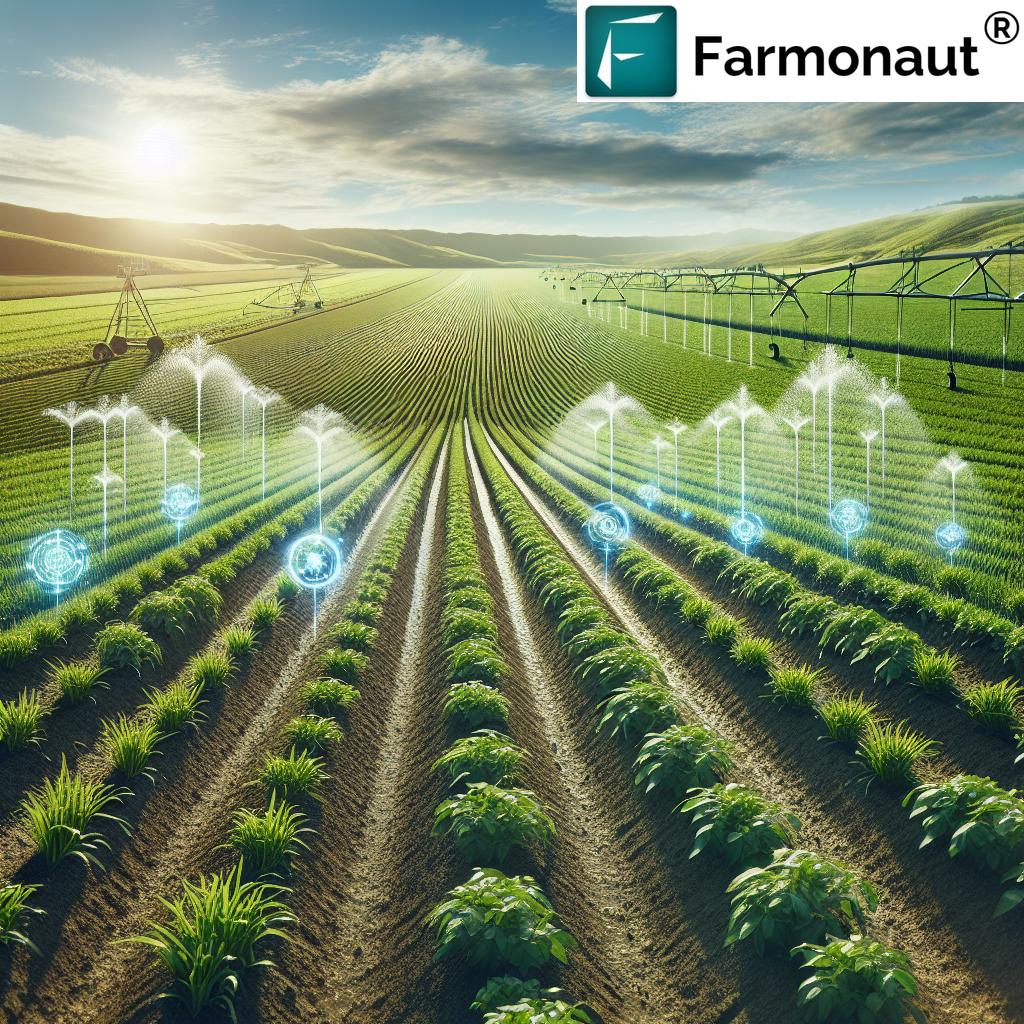Alfalfa Crop Guide 2025: Proven Nutrient & Yield Strategies
“Applying 30-40 kg/ha of phosphorus increases alfalfa yield by up to 25% during early growth stages.”
Table of Contents
- Alfalfa Crop Production: 2025 Overview
- Alfalfa Growth Stages Management Table
- Key Factors Affecting Alfalfa Yield
- Soil Preparation and Sowing for Alfalfa
- Using NDVI & NDWI for Alfalfa Crop Management
- Proven Alfalfa Nutrient Management Strategies
- Irrigation Management Techniques for Alfalfa
- Integrated Weed, Pest, and Disease Management
- Efficient Alfalfa Harvesting & Regrowth Practices
- Localized Alfalfa Advisory: India, California, Greece & More
- Advanced Tools: Satellite, AI & App-Based Alfalfa Solutions
- Frequently Asked Questions (FAQ)
Alfalfa Crop Production: 2025 Overview
Alfalfa (Medicago sativa), the “Queen of Forages,” continues to underpin global fodder and livestock production into 2025 and beyond. Demand for high-nutrient forage remains strong across India, North America, Mediterranean countries (like Greece), and emerging semi-arid regions. To maximize yields and ensure sustainability, growers must integrate the latest research-based strategies in soil, nutrient management, NDVI monitoring, irrigation, pest control, and harvest scheduling. This comprehensive guide synthesizes proven recommendations, focus keyword best practices, and region-specific advisory content for high-performance, resilient alfalfa crops.
In this blog, we:
- Guide you through optimal alfalfa management at each growth stage
- Define target NDVI, soil composition, and nutrient application by phase—from establishment and vegetative boost to post-harvest regrowth
- Deliver actionable, research-based and location-relevant advice for 2025 and beyond
- Highlight the value of NDVI, NDWI, AI, and satellite-driven monitoring
- Link to carbon footprinting tools, traceability solutions, large-scale management, and more.
Focus Keywords Featured:
alfalfa, soil, growth, ndvi, crop, irrigation, stage, range, early, previous, organic, current, typical, nutrient, source, yield, n, based, production, p, typically, management, and more—carefully included for 2025 relevancy, SEO best practices, and user value.
Alfalfa Growth Stages Management Table
Understanding and managing every stage of the alfalfa crop cycle is vital for consistent, high-quality forage production. Here’s our all-in-one table of actionable metrics:
| Growth Stage | NDVI Range (Estimated) |
Recommended Nutrient Application (N-P-K Values kg/acre) |
Irrigation (inches/week) |
Pest/Disease Risks | Expected Yield (ton/acre) |
|---|---|---|---|---|---|
| Seedling (Germination/Emergence) | 0.15 – 0.30 | 5N – 10P – 15K (Starter) | 0.75 – 1 | Seedling rot, Damping-off, Aphids | Up to 0.3 (initial forage cut) |
| Early Vegetative Growth | 0.40 – 0.65 | 10N – 18P – 30K (Base+Topdress if needed) |
1 – 1.5 | Root rot, Cutworms, Grass weeds | 0.4 – 0.7 |
| Mid Vegetative (Pre-bud/Bud) | 0.65 – 0.85 | Topdress if NDVI low: 10N – 10P – 15K |
1 – 1.8 | Downy mildew, Aphids, Broadleaf weeds | 0.7 – 1.2 |
| Bud, Early Flowering | 0.65 – 0.85 (peak) | P: 0–10, K: 0–15 (if deficiency observed) |
1.0 – 1.5 | Mildew, Weevil, Wilt | 1.0 – 1.8 |
| Full Flower | 0.55 – 0.75 | Monitor only, generally no further N, possible micro-nutrient topdress | 0.75 – 1.0 | Leaf spot, Wilt, Armyworm (Late cut risk) | 1.2 – 2.2 |
| Post-Harvest/Regrowth Cycles | 0.25 – 0.45 (post-cut), rising thereafter | 5N – 10P – 10K (after 2-3 cuts or low NDVI) |
1.0 – 1.3 | Weeds, Aphids, Rust, Residual rot | Variable, 80–90% of first cut |
“Maintaining NDVI values between 0.65 and 0.85 indicates optimal alfalfa health and maximized nutrient absorption.”
Key Factors Affecting Alfalfa Yield in 2025
- Soil quality and organic matter: Adequate soil organic carbon (SOC)—optimally at 1.5-3%—enhances root development, moisture retention, and nutrient cycling (USDA NRCS).
- Field pH and salinity: Alfalfa thrives in slightly acidic to neutral soils (pH 6.5–7.5). Salinity should be monitored especially in irrigated regions or flood-irrigated fields to prevent root damage.
- NDVI and NDWI monitoring: NDVI values below 0.40 indicate sparse vegetation, possible weed invasion, or post-harvest status; optimum yield is tied to sustained NDVI 0.65–0.85 during peak vegetative stages. NDWI complements by measuring crop water status.
- Stage-specific nutrient management: Correct timing and dosage of NPK, S, Zn (plus organic inputs) close critical yield gaps.
- Strategic pest, disease, and weed control: Aphids, weevils, downy mildew and common broadleaf or grassy weeds can swiftly limit alfalfa stand establishment and regrowth, especially in India, the Mediterranean, and California.
- State-of-the-art remote sensing and advisory support: Satellite data, such as that processed by Farmonaut’s platform, delivers real-time diagnostics, which are critical for AI-driven, field-specific advisory and resource optimization.
- Timely, multiple harvests: “Cutting at the right stage,” (bud to early bloom, every 25–35 days in multi-cut systems) maintains plant vigor and supports optimal regrowth.
Soil Preparation and Sowing for Alfalfa: Foundation for High Yields
Key Points:
- Optimal sowing windows (by region):
- India (Maharashtra/Telangana): October–November (post-monsoon), February–March
- California: September–October (fall is preferred for best establishment)
- Mediterranean—Greece: September–October (autumn), March–April (early spring)
- South Africa: March–May (autumn, before the dry season)
- Soil pH: Target pH 6.5–7.5; adjust with lime (if acidic) or gypsum (if excessive sodium/salinity). Farmonaut tools can monitor spatial pH variability using historical data and AI-based predictions.
- Ploughing, harrowing, and laser leveling create a fine seedbed—reducing weed competition and improving uniform seed depth (1–1.5 cm) for rapid germination.
- Base nutrient application (see table above)—especially critical if soil organic matter is below optimal.
Starter Fertilizer Strategy for New Stands
- N: 5–10 kg/acre, only for non-legume establishment or if previous field had no recent legume crop; use urea, DAP, or manure.
- P: 18–28 kg/acre as SSP, DAP, or composted manure; deficiency at this stage severely limits root development.
- K: 35–50 kg/acre as MOP, SOP, or wood ash, especially for sandy or intensively irrigated soils.
- S: 10–18 kg/acre as gypsum, ammonium sulfate, or FYM.
-
Zn: 1–2 kg/acre as ZnSO4 or zincated compost.
(Nutrient rates as per standard guides from University of California, Indian Journal of Agronomy 2021, and local advisories for India and Greece)
Farmonaut Product Traceability Solution: Ensure every batch of alfalfa forage from your field is verifiable. Blockchain-driven record-keeping helps buyers audit quality, improves export compliance, and strengthens your brand’s trust.
Using NDVI & NDWI for Alfalfa Crop Management
What are NDVI and NDWI?
- NDVI (Normalized Difference Vegetation Index): Satellite-derived index that quantifies live green biomass, indicating crop vigor, stage, and uniformity. Values typically range from 0 (bare soil) to 0.9 (dense, healthy canopy).
- NDWI (Normalized Difference Water Index): Measures vegetation water content; values >0.3 typically mean adequate water and low drought stress.
Main Application in Alfalfa Management:
NDVI & NDWI mapping allows in-season detection of stress, harvest timing, and spatial variability—enabling:
- Timely irrigation or nutrient amendments
- Early detection of pest/disease or weed outbreaks
- Stage-based harvest scheduling (post-peak NDVI)
In our advanced Farmonaut platform, NDVI/NDWI trends are displayed alongside AI advisories for both single fields (per-acres in India, US, South Africa, etc.) or large enterprise blocks. This data is used to tailor per-stage action plans and ensure optimal forage production in both irrigated and rainfed conditions.
Typical NDVI Ranges By Growth Stage (Summary)
- Germination/Establishment: 0.15–0.30
- Early Vegetative: 0.40–0.65
- Mid Vegetative (Bud/Pre-bud): 0.65–0.85
- Full Flower: 0.55–0.75
- Post-harvest/Regrowth: 0.25–0.45 (immediately after cut), rising thereafter
Maintaining NDVI between 0.65 and 0.85 throughout vigorous growth is highly correlated with optimal nutrient absorption and yield. Sudden drops indicate stress—due to weeds, low nutrients, pest/disease, or water deficit.
Example: NDVI & NDWI in India, California, Greece (2023–2025 Data)
-
Maharashtra (India):
Early regrowth after a cut: NDVI 0.4–0.6; healthy vegetative stage (pre-bud): NDVI 0.65–0.8; immediate post-harvest: NDVI 0.25–0.4. -
California (US):
Germination/Emergence: NDVI 0.15–0.3;
Vegetative (early–pre-flower): NDVI 0.7–0.85;
Post-harvest: NDVI 0.29–0.4. -
Greece (Mediterranean, Achaia):
Seedling: NDVI 0.2–0.4;
Vegetative (early): NDVI 0.4–0.65;
Budding: NDVI 0.65–0.7.
Monitor & Reduce Alfalfa’s Carbon Footprint:
Use Farmonaut’s carbon tracking tools to track, manage, and minimize your field’s carbon emissions. Optimize nitrogen inputs, reduce run-off, and document sustainable forage practices for 2025 and beyond!
Proven Alfalfa Nutrient Management Strategies (2025)
1. Nitrogen (N)
- Being a strong legume, alfalfa fixes most N via Rhizobium symbiosis; however, starter N (as urea or ammonium-based fertilizer) at seeding (5–10 kg/acre) is beneficial especially in low organic matter soils or where previous crop was not a legume.
- Excess N (especially topdressed or late in stand life) can suppress nodulation, promote weeds, and is not recommended unless NDVI is abnormally low and tissue/N test confirms deficiency.
2. Phosphorus (P)
-
Critical in early establishment: Apply 18–28 kg/acre P (as SSP, DAP, or bone meal; organic compost can supplement) at planting.
Research from the Indian Journal of Agronomy (2021): Applying 30–40 kg/ha phosphorus increases yield by up to 25% in early growth. - Maintenance doses after 2–3 cuts, or as guided by soil test/advisory. Watch for moderate–high criticality gap if available values are below 13 kg/acre.
3. Potassium (K)
- Apply 35–60 kg/acre at sowing, maintain with 15–30 kg/acre between cuts if NDVI is below range or soil K is below 90 kg/acre. Sources: MOP (Muriate of Potash, KCl), SOP, or wood ash.
- Low potash or waterlogging (especially in Mediterranean or irrigated Indian soils) increases susceptibility to wilt and root rot.
4. Sulfur (S) and Zinc (Zn)
- Sulfur: 10–18 kg/acre at sowing; sources include gypsum, ammonium sulfate, compost, or FYM. Symptoms of S deficiency are yellowing in new leaves.
- Zinc: 1–2 kg/acre as zinc sulfate or zincated compost/manure. Zn is vital for stress tolerance, root growth, and nodulation.
5. Organic Amendments & Methods
- Farmyard Manure (FYM) and well-decomposed compost are recommended both at sowing and at regrowth cycles. Improves soil structure, enhances microbes, reduces fertilizer leaching, and gently balances soil pH.
- Broadcast and incorporate before sowing/cut; avoid waterlogging for decomposition.
- Wood ash (for K), bone meal (for P), zincated compost: Apply based on soil analysis, region, and advisory prediction.
Why is nutrient management so critical in alfalfa?
- It’s a multi-cut crop: Nutrients are removed multiple times each season—topdress as per growth stage and NDVI.
- Deficiencies often only become apparent (yellowing, thinning, stunted regrowth, poor stand) after significant yield is lost—thus, predictive and data-driven management is valuable!
- If soil organic carbon is critically low (under 1.5%), yields are capped no matter how much urea, DAP, MOP, or compost is applied.
For advanced, per-field, or per-cut recommendations, Farmonaut API provides developers and agronomic teams with field-wise satellite-derived data, fertilizer status, and stage-based AI coaching.
Focus on Irrigation Management in Alfalfa
- Preferred methods, by region:
- Flood irrigation: Most common in India, California, and Greece—allows uniform wetting but can increase risk of salinity and waterlogging if fields are not laser-leveled or have poor drainage.
- Sprinkler irrigation: Recommended in semi-arid zones, South Africa, Mediterranean valleys—improves distribution and reduces salinity buildup.
-
Stage-based scheduling:
- Germination and seedling phase: 0.75–1 inch/week (applied in 2–3 applications)—keep the upper 2–3 inches moist for rapid emergence.
- Active vegetative phase/bud stage: 1.1–1.8 inches/week (or 4–6 mm daily), more in hot/dry regions.
- Early regrowth (after cut): Frequent, light irrigation (4–5 mm every 2–3 days)—especially in Mediterranean and Indian autumn cycles.
- NDWI-guided management: If NDWI drops below 0.3 during vegetative stage, irrigate immediately to avoid stress. Our AI system recommends skip schedules or increased frequency depending on stage, weather, and soil water holding capacity.
-
Salinity management:
Avoid excess muriate of potash (MOP) and monitor drainage effectiveness. Long-term, use gypsum to offset sodium/clay buildup; avoid excessive fertilizer banding in poorly drained plots. - Water quality: Regularly check EC (Electrical Conductivity) of water. Saline water (>1.5 dS/m) increases soil salinity; leach with rain/clear water periodically.
To automate and optimize your irrigation for variable field conditions, Farmonaut Fleet & Resource Management Tools can be used to schedule water/fertilizer distribution and integrate soil–satellite data, improving yield and cost efficiency.
Integrated Pest, Disease & Weed Management in Alfalfa
Major Weeds: Identification & Control
-
Grassy weeds: Barnyardgrass, crabgrass, ryegrass, foxtail.
Control: Sethoxydim or pendimethalin (pre-emergent); manual or mechanical removal for organic fields. -
Broadleaf weeds: Parthenium, Amaranthus, lambsquarters, pigweed, wild oats, Cynodon dactylon.
Control: 2,4-DB application (chemical); frequent shallow hoeing, mulching (organic). - Mediterreanean/Greece: Annual ryegrass, lambsquarters, wild oats prevalent at early and mid-vegetative stage.
Weed competition is especially critical after harvest and during early vegetative stages. Low NDVI (0.25–0.40) post-cut can mean both low crop cover and high weed emergence.
Common Alfalfa Pests & Recommended Actions
-
Aphids: Sap-sucking, stunting, and transmit mildew viruses; greatest risk in warm, humid, early regrowth windows.
Control: Imidacloprid, neem oil sprays; encourage ladybird beetles for biological management. -
Alfalfa weevil: Defoliates regrowth and mid-veg alfalfa (common in India, California, SA, Greece).
Control: Lambda-cyhalothrin, biological agents; monitor NDVI for localized stress patches. -
Caterpillars/Armyworms: Heavy infestations in dense, moist canopies.
Control: Spinosad, Bacillus thuringiensis (Bt) (organic).
Top Alfalfa Diseases and Defense
-
Downy mildew (Peronospora trifoliorum): Favors high humidity, especially post-monsoon in India and Mediterranean climates
Control: Mancozeb (chemical), copper fungicide/bio-control (organic), early-morning irrigation, improve air circulation. -
Leaf spot and stemphylium: Brown/black spots, yellowing, especially in stressed stands.
Control: Azoxystrobin or chlorothalonil, prune infected leaves, avoid excess N. -
Root rots (Rhizoctonia, Fusarium, Phytophthora): Occurs in saline/waterlogged or nutrient-deficient fields.
Control: Rotate fields, improve drainage, avoid waterlogging. - Rust, Wilt: More common with high relative humidity and susceptible varieties.
Farmonaut Advisory Integration
Our AI-driven advisories automatically assess pest/disease and weed probability based on NDVI, NDWI, stage, previous local incidence, and current meteorological data. This enables prompt, targeted interventions and reduces losses.
Want to streamline irrigation, pest, and fertilizer scheduling across multiple crops alongside alfalfa?
Use the Agro Admin App for Large Scale Farm Management and centralize your data, advisories, and field monitoring.
Efficient Alfalfa Harvesting & Regrowth Practices
- Multi-cut system preferred: First cut at 60–75 days (when 10–20% bloom); subsequent cuts every 25–35 days (India, CA, Med). Yields typically increase with 3–8 cuts/year—weather, irrigation, and stage-dependent.
-
Key metrics for decision:
- NDVI plateauing or beginning to drop
- Visible early bloom (10–15% of plants flowering)
- Field records (+ Farmonaut’s AI) indicate optimal dry matter percentage
- Regrowth period: Maintain consistent irrigation, early weed/pest intervention, and (if needed) foliar zinc/sulfur supplementation. NDVI should rise from 0.25+ to 0.65+ within 15–25 days post-cut in healthy systems.
Estimated Realistic Yield Ranges (2023–2025 Data):
- India (irrigated): 12,000 – 20,000 kg/acre/year; record: 25,000 kg/acre
- California/US: 11,200 – 17,920 kg/acre/year; record: 22,400 kg/acre
- Mediterranean (Greece): 1,000 – 2,000 kg/acre/year; record: 2,500 kg/acre
- South Africa/Namibia: 4,000 – 8,000 kg/acre/year; record: 12,000 kg/acre
Localized Alfalfa Advisory: India, California, Greece & More (2025)
India (Indapur, Maharashtra & Telangana)
- Sowing: October–November, February–March. Flood irrigation typical.
- Nutrients: DAP or SSP as base P, MOP or SOP for K, Zinc sulfate (if Zn is low, esp. in calcareous soils); heavy use of FYM, compost to build SOC.
- Key advisories: NDVI 0.4 (early regrowth); NDVI 0.65+ (mid-veg); minor N starter needed only if previous crop not legume; monitor for aphids, weevil, mildew post-cut.
- Weeds: Parthenium, Cynodon, Amaranthus, pigweed—remove early.
- Typical yields: 12–20 ton/acre/year, up to 25 ton/acre/year under best practices.
California (Kings County & Central Valley)
- Sowing: Fall (Sept–Oct) for best establishment.
- Primary nutrients: High P and K requirement; N not required after stand establishment; micro-Zn and S if leaf test/AI shows deficiency. Flood irrigation most common, shifting to sprinkler/drip.
- NDVI/NDWI: Germination 0.15–0.3, peak 0.7–0.85, post-harvest 0.29–0.4. Flood/sprinkler schedules: 1.0–1.5 inch/week peak growth.
- Major threats: Alfalfa weevil, potato leafhopper, root rots; common lambsquarters, pigweed, barnyardgrass.
- Realistic yields: 11,200–17,920 kg/acre; up to 22,400 kg/acre best-case.
Greece & Mediterranean (Achaia, EU South)
- Sowing: September–October (autumn), March–April (spring).
- Sprinkler irrigation preferred, 0.75–1.2 inch/week depending on ET and NDWI.
- Key fertilizer regime: Base P and K, S, and moderate starter N, especially in new fields; regular Zn (as zinc sulfate or compost) if leaf/test is low. Compost and manure regularly incorporated to improve typically poor Mediterranean soils.
- NDVI range: Seedling 0.2–0.4, early veg 0.4–0.65, bud 0.65–0.7, post-cut 0.3–0.4.
- Disease/pest control: Integrated—monitor for ryegrass, wild oats, downy mildew, aphid outbreaks especially in humid periods.
- Yield: 1–2 ton/acre typical annual, up to 2.5 ton best local case.
South Africa (Pixley ka Seme & Similar Climatic Regions)
- Sowing: Autumn preferred (March–May).
- Primary fertilizer regime: Emphasize P, K, S, Zn at establishment; minimize/avoid N after first month. Sprinkler irrigation to mitigate water stress and salt accumulation.
- NDVI: Seedling/early growth 0.3–0.5, peak 0.7–0.9.
- Pest & diseases: Aphids, leaf spot, rust, redlegged earth mite—manage with timely scouting and biocontrol if possible.
- Yields: 4–8 ton/acre/year; up to 12 ton/acre record.
Advanced Tools for 2025: Satellite, AI, and App-Based Alfalfa Solutions
In the coming years, real-time, affordable satellite-driven data will empower even small-scale forage growers to maximize yield, lower input costs, and meet sustainability standards.
Farmonaut’s Suite of Alfalfa Solutions:
- Remote Sensing Platform: Access advanced NDVI, NDWI, stage prediction, and field analytics on the web (or via Android/iOS).
- AI-Powered Advisory: The Jeevn AI system combines current NDVI with local weather, soil composition, and previous advisories—delivering actionable, field-specific plans for every cycle.
- Carbon Footprinting: Track and benchmark field-level emissions for sustainability certifications.
- Traceability: Blockchain record of every cut: From field to feedlot, ensure buyers can verify input integrity.
- Fleet Management and resource scheduling: Optimize field machinery and irrigation for every cut.
To learn more about Farmonaut’s products or how to embed these insights in your agricultural enterprise or advisory platform, visit our API documentation.
Frequently Asked Questions (FAQ): Alfalfa Nutrient & Yield Management 2025
-
Q: What is the optimal soil pH for alfalfa?
A: Neutral to slightly acidic, pH 6.5–7.5. Liming is recommended for fields below 6.5; use gypsum to fix high salinity or sodicity. -
Q: How can I use NDVI to time my alfalfa harvests?
A: Harvest when NDVI peaks (typically 0.65–0.85) or just begins to decline. Lower NDVI values after cutting signal regrowth starting (0.25–0.45). -
Q: Should I apply nitrogen to established alfalfa?
A: Only in low organic matter soils, poor nodulation, or for new stands. Overuse can suppress fixation and increase weeds. -
Q: Which organic sources boost alfalfa yield best?
A: Well-rotted farmyard manure, compost, wood ash (for K), bone meal (for P), and zincated manure/compost are proven boosters. Apply pre-sowing and after 2–3 harvests. -
Q: How frequently should I irrigate during regrowth?
A: Every 2–3 days with 4–6 mm/application (adjust if NDWI below 0.3 or in hot, dry weather). -
Q: Which pests and diseases are most common, and how do I manage them?
A: Pests: Aphids, alfalfa weevil, leafhoppers. Diseases: Downy mildew, root rot. Use integrated management with rotation, resistant varieties, best field hygiene, and targeted AI-driven scouting. -
Q: What is the best way to ensure high soil organic carbon?
A: Regularly return organic matter—manure, compost, green manures—and minimize bare fallow. Use minimum tillage where possible (Learn more about regenerative agriculture and carbon management). -
Q: Why track carbon footprint in alfalfa production?
A: Emerging global markets demand low-carbon, verified fodder for premium pricing and access—carbon tracking will become crucial for compliance and sustainability. -
Q: Can I integrate Farmonaut’s advisory into my own app or agronomy system?
A: Yes, via Farmonaut’s APIs and developer resources. Leverage near real-time satellite and AI data for your users!
Summary & Next Steps
The 2025 Alfalfa Crop Guide gives you a neutral, actionable blueprint—from starter fertilizer rates and NDVI-informed irrigation to multi-cut pest management and advanced remote sensing—for consistently maximizing both yield and quality in your alfalfa crop, whatever your local climate, soil, or water conditions.
By optimizing soil organic matter, tailoring fertilizer and water by growth stage, and using modern AI and satellite data for in-season adjustments, success in irrigated, rainfed, organic, and conventional systems is within reach.
- Download the Farmonaut app (see links above) for real-time, field-specific guidance.
- Use our carbon-footprinting tool and traceability services for sustainable market access.
- Integrate Farmonaut’s satellite API for custom advisory in your agri-business, financial service, or government app.
Ready to maximize your 2025 alfalfa yields?
Let satellite, AI, and data-driven agronomy guide your next cut!














